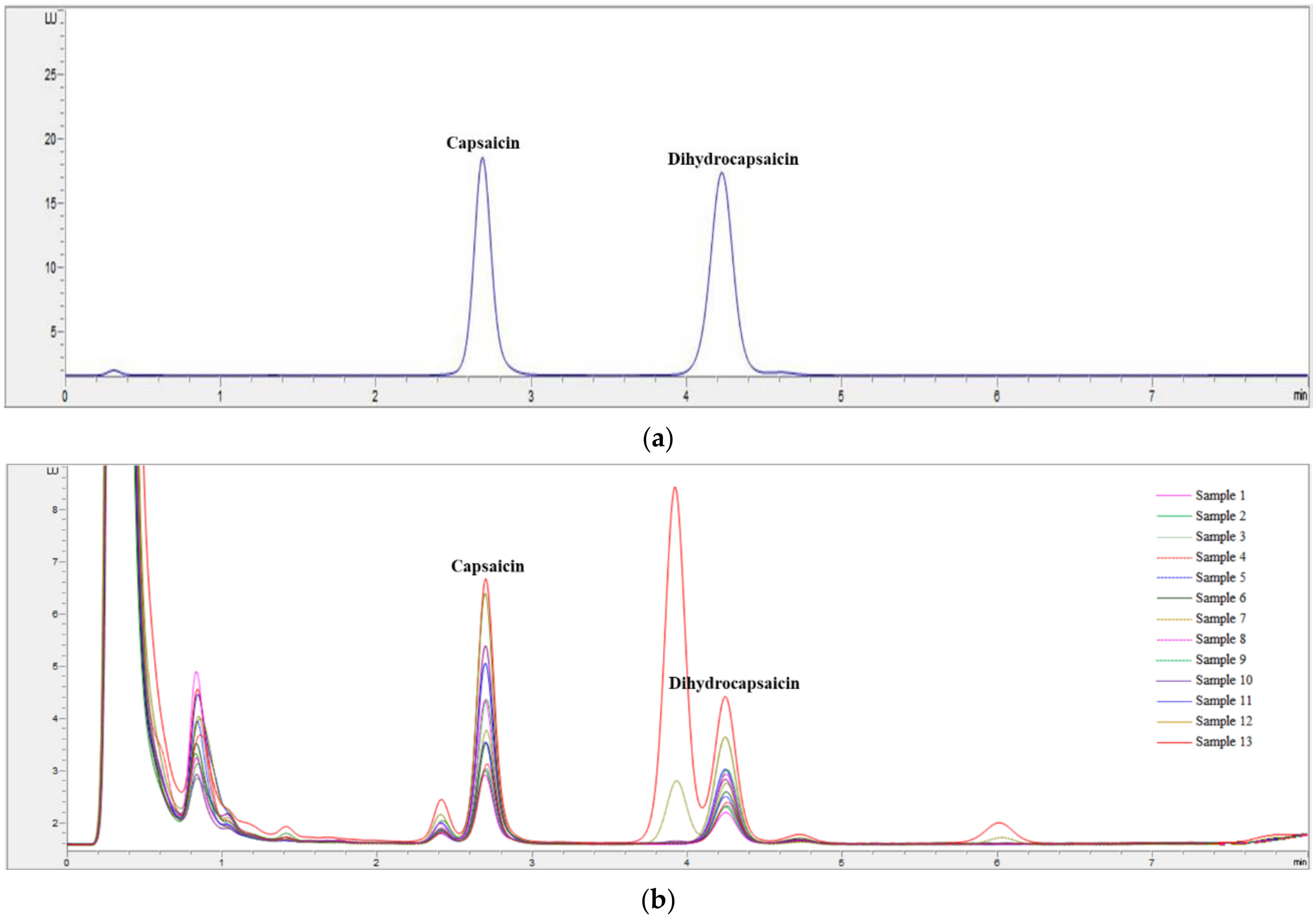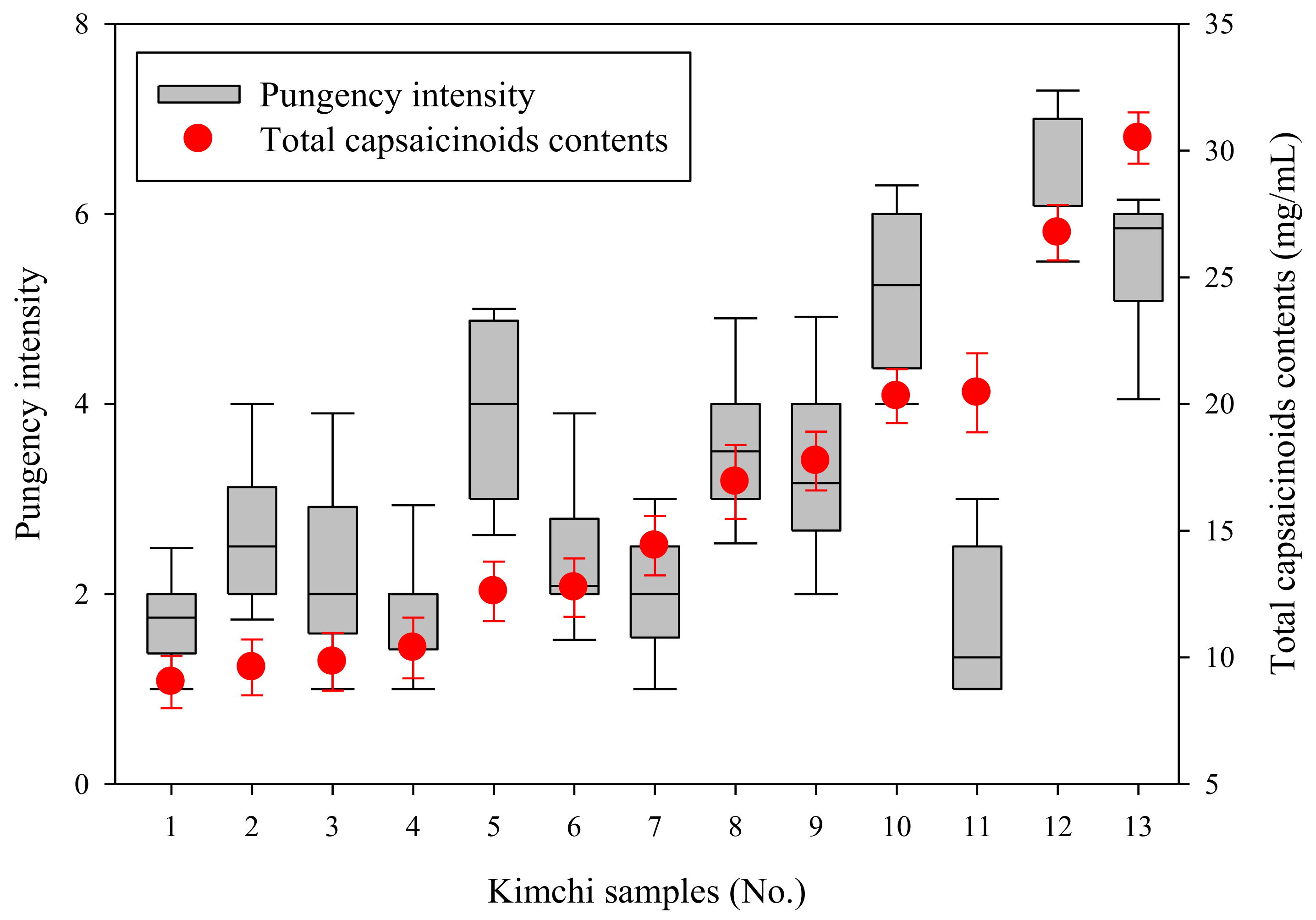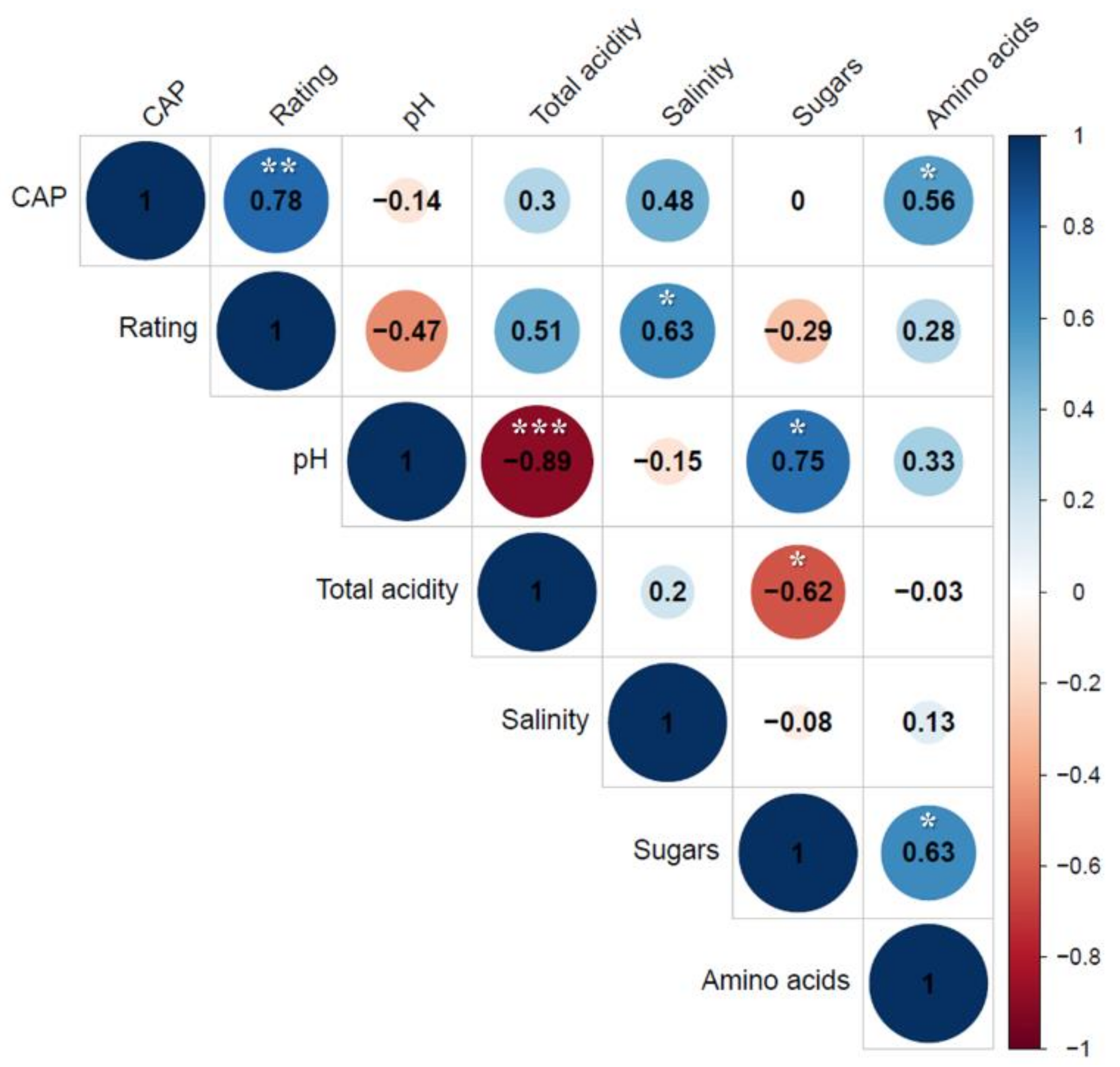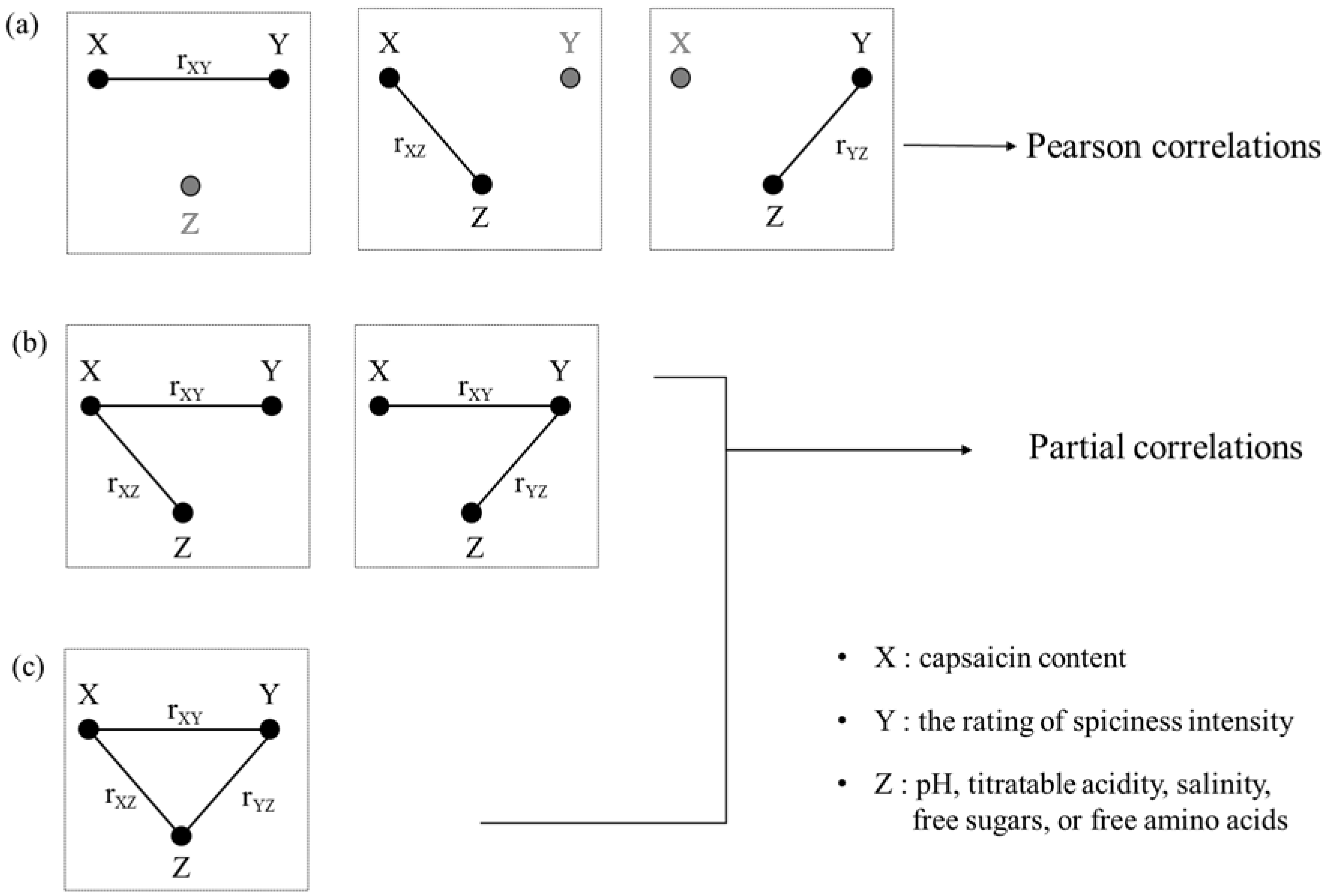Correlating Capsaicinoid Levels and Physicochemical Proper-ties of Kimchi and Its Perceived Spiciness
Abstract
1. Introduction
2. Materials and Methods
2.1. Kimchi Samples
2.2. Determination of Physicochemical Properties of Kimchi
2.2.1. Assessment of Capsaicin and Dihydrocapsaicin Content
2.2.2. pH and Titratable Acidity
2.2.3. Salinity
2.2.4. Determination of Free Sugar Content
2.2.5. Determination of Free Amino Acid Content
2.3. Descriptive Analysis of the Spiciness of Kimchi
2.3.1. Panel Selection
2.3.2. Reference Sample Evaluation
2.3.3. Panel Training
2.3.4. Kimchi Sample Evaluation
2.4. Analysis Using Simple and Partial Correlation Coefficients
2.5. Statistical Analysis
3. Results and Discussion
3.1. Physicochemical Properties of Commercial Kimchi
3.2. Capsaicinoid Content of 13 Commercial Kimchi Samples
3.3. Sensory Evaluation of Spiciness of Commercial Kimchi
3.4. Correlation between Physicochemical Parameters and Spiciness
4. Conclusions
Supplementary Materials
Author Contributions
Funding
Institutional Review Board Statement
Informed Consent Statement
Data Availability Statement
Acknowledgments
Conflicts of Interest
References
- Ji, Y.S.; Kim, H.N.; Park, H.J.; Lee, J.E.; Lee, H.J.; Shin, H.K.; Kim, B.J.; Franz, C.M.A.P.; Holzapfel, W.H. Functionality and safety of lactic bacterial strains from Korean kimchi. Food Control 2013, 31, 467–473. [Google Scholar] [CrossRef]
- Kim, M.K.; Lee, M.A.; Lee, K.G. Determination of compositional quality and volatile flavor characteristics of radish-based Kimchi suitable for Chinese consumers and its correlation to consumer acceptability. Food Sci. Biotechnol. 2018, 27, 1265–1273. [Google Scholar] [CrossRef]
- Kang, S.; Kim, S.J.; Kim, S.H.; Lee, J.H.; Park, S.Y.; Ha, S.D. Comparison of the murine norovirus-1 inactivation in cabbage Kimchi with two different salinities during storage. Food Res. Int. 2016, 84, 96–101. [Google Scholar] [CrossRef]
- Cliff, M.; Heymann, H. Descriptive analysis of oral pungency. J. Sens. Stud. 1992, 7, 279–290. [Google Scholar] [CrossRef]
- Guzmán, I.; Bosland, P.W. Sensory properties of chili pepper heat—And its importance to food quality and cultural preference. Appetite 2017, 117, 186–190. [Google Scholar] [CrossRef] [PubMed]
- Lee, M.A.; Choi, Y.J.; Kim, M.K. Qualitative consumer preference studies on Korean-style kimchi in Chinese living in Korea. J. East Asian Soc. Diet. Life 2017, 27, 185–193. [Google Scholar] [CrossRef]
- Jang, S.H.; Kim, M.J.; Lim, J.Y.; Hong, J.H. Cross-cultural comparison of consumer acceptability of Kimchi with different degree of fermentation. J. Sens. Stud. 2016, 31, 124–134. [Google Scholar] [CrossRef]
- Park, H.J.; Ko, J.M.; Lim, J.Y.; Hong, J.H. American consumers’ perception and acceptance of an ethnic food with strong flavor: A case study of Kimchi with varying levels of red pepper and fish sauce. J. Sci. Food Agric. 2020, 100, 2348–2357. [Google Scholar] [CrossRef] [PubMed]
- Ku, K.H.; Lee, K.A.; Park, J.B. Physicochemical properties and sensory evaluation for the heat level (hot taste) of Korean red pepper powder. Prev. Nutr. Food Sci. 2012, 17, 29–35. [Google Scholar] [CrossRef]
- Perucka, I.; Oleszek, W. Extraction and determination of capsaicinoids in fruit of hot pepper Capsicum annuum L. by spectrophotometry and high-performance liquid chromatography. Food Chem. 2000, 71, 287–291. [Google Scholar] [CrossRef]
- Gibbs, H.A.A.; O’Garro, L.W. Capsaicin content of West Indies hot pepper cultivars using colorimetric and chromatographic techniques. HortScience 2004, 39, 132–135. [Google Scholar] [CrossRef]
- Barbero, G.F.; Palma, M.; Barroso, C.G. Pressurized liquid extraction of capsaicinoids from peppers. J. Agric. Food Chem. 2006, 54, 3231–3236. [Google Scholar] [CrossRef] [PubMed]
- Peña-Alvarez, A.; Ramírez-Maya, E.; Alvarado-Suárez, L.A. Analysis of capsaicin and dihydrocapsaicin in peppers and pepper sauces by solid phase microextraction-gas chromatography-mass spectrometry. J. Chromatogr. A 2009, 1216, 2843–2847. [Google Scholar] [CrossRef] [PubMed]
- Kaale, E.; Van Schepdael, A.; Roets, E.; Hoogmartens, J. Determination of capsaicinoids in topical cream by liquid—Liquid extraction and liquid chromatography. J. Pharm. Biomed. Anal. 2002, 30, 1331–1337. [Google Scholar] [CrossRef]
- Kozukue, N.; Han, J.S.; Kozukue, E.; Lee, S.J.; Kim, J.A.; Lee, K.R.; Levin, C.E.; Friedman, M. Analysis of eight capsaicinoids in peppers and pepper-containing foods by high-performance liquid chromatography and liquid chromatography-mass spectrometry. J. Agric. Food Chem. 2005, 53, 9172–9181. [Google Scholar] [CrossRef]
- Liu, L.; Chen, X.; Liu, J.; Deng, X.; Duan, W.; Tan, S. Determination of capsaicin and dihydrocapsaicin in Capsicum anuum and related products by capillary electrophoresis with a mixed surfactant system. Food Chem. 2010, 119, 1228–1232. [Google Scholar] [CrossRef]
- Chai, J.Y.; Kim, M.S.; Han, I.K.; Lee, S.Y.; Yeo, I.H. Relationships between the content and sensory evaluation of pungent principles in red pepper. Anal. Sci. Technol. 1994, 7, 541–545. [Google Scholar]
- Lee, H.D.; Kim, M.H.; Lee, C.H. Relationship between the taste components and sensory preference of Korean red peppers. Korean J. Food Sci. Technol. 1992, 24, 266–271. [Google Scholar]
- Chambers, E.; Lee, J.H.; Chun, S.; Miller, A.E. Development of a exicon for commercially available cabbage (Baechu) Kimchi. J. Sens. Stud. 2012, 27, 511–518. [Google Scholar] [CrossRef]
- Lee, K.W.; Kim, K.O. Effects of fat and sucrose in palate cleansers on discrimination of burning sensation of capsaicin samples. Food Sci. Biotechnol. 2013, 22, 691–696. [Google Scholar] [CrossRef]
- AOAC (Official Methods of Analysis of the Association of Official Analytica l Chemists). Sodium chloride in canned vegetable, Method 971.27. In Official Methods of Analysis of the Association of Official Analytical Chemists International, 17th ed.; Horwitz, W., Ed.; Byrd Press Inc.: Richmond, VA, USA, 2000; Volume II, pp. 7–8. [Google Scholar]
- Park, B.Y.; Yang, J.S.; Moon, E.W.; Seo, H.Y.; Ha, J.H. Influence of capsaicinoids content on the microbial community during kimchi fermentation. J. Microbiol. Biotechnol. 2019, 29, 1580–1590. [Google Scholar] [CrossRef] [PubMed]
- Hootman, R. (Ed.) Manual on Descriptive Analysis Testing for Sensory Evaluation; ASTM International: West Conshohocken, PA, USA, 1992. [Google Scholar] [CrossRef]
- Lee, J.H.; Jeong, D.W.; Kim, M.K. Influence of bacterial starter cultures on the sensory characteristics of doenjang, a fermented soybean paste, and their impact on consumer hedonic perception. J. Sens. Stud. 2019, 34, e12508. [Google Scholar] [CrossRef]
- Sokal, R.; Rohlf, F.J. Biometry: The Principles and Practice of Statistics in Biological Research, 3rd ed.; W. H. Freeman and Company: New York, NY, USA, 1995; pp. 21–25. [Google Scholar]
- Lim, J.H.; Park, S.S.; Jeong, J.W.; Park, K.J.; Seo, K.H.; Sung, J.M. Quality characteristics of kimchi fermented with abalone or sea tangle extracts. J. Korean Soc. Food Sci. Nutr. 2013, 42, 450–456. [Google Scholar] [CrossRef]
- Lee, M.; Song, J.H.; Jung, M.Y.; Lee, S.H.; Chang, J.Y. Large-scale targeted metagenomics analysis of bacterial ecological changes in 88 kimchi samples during fermentation. Food Microbiol. 2017, 66, 173–183. [Google Scholar] [CrossRef] [PubMed]
- Park, S.E.; Yoo, S.A.; Seo, S.H.; Lee, K.I.; Na, C.S.; Son, H.S. GC–MS based metabolomics approach of Kimchi for the understanding of Lactobacillus plantarum fermentation characteristics. LWT Food Sci. Technol. 2016, 68, 313–321. [Google Scholar] [CrossRef]
- Hong, S.I.; Park, J.S.; Park, N.H. Relationships between fermentative gas pressure and quality changes of packaged kimchi at different temperatures. Korean J. Food Sci. Technol. 1994, 26, 770–775. [Google Scholar]
- Hong, S.I.; Park, J.S.; Park, N.H. Quality changes of commercial kimchi products by different packaging methods. Korean J. Food Sci. Technol. 1995, 27, 112–118. [Google Scholar]
- Jung, J.Y.; Lee, S.H.; Kim, J.M.; Park, M.S.; Bae, J.W.; Hahn, Y.; Madsen, E.L.; Jeon, C.O. Metagenomic analysis of kimchi, a traditional Korean fermented food. Appl. Environ. Microbiol. 2011, 77, 2264–2274. [Google Scholar] [CrossRef]
- Zhao, C.J.; Schieber, A.; Gänzle, M.G. Formation of taste-active amino acids, amino acid derivatives and peptides in food fermentations—A review. Food Res. Int. 2016, 89, 39–47. [Google Scholar] [CrossRef]
- Todd, P.H.; Bensinger, M.G.; Biftu, T. Determination of pungency due to capsicum by gas-liquid chromatography. J. Food Sci. 1977, 42, 660–665. [Google Scholar] [CrossRef]
- Schneider, D.J.; SeuB-Baum, I.; Schlich, E. Comparison between chemical senses thresholds for capsaicin and dihydrocapsaicin in aqueous solutions and identification of the area of burning sensation. Adv. J. Food Sci. Technol. 2014, 6, 36–41. [Google Scholar] [CrossRef]
- Salkind, N.J. Statistics for People Who (Think They) Hate Statistics, 5th ed.; SAGE Publications: Newbury Park, CA, USA, 2016; Volume 127–128. [Google Scholar]
- Melissa, A.S.; Raghuraj, K.R.; Lakshminarayanan, S. Partial correlation metric based classifier for food product characterization. J. Food Eng. 2009, 90, 146–152. [Google Scholar] [CrossRef]
- Stevens, D.A.; Lawless, H.T. Putting out the fire: Effects of tastants on oral chemical irritation. Percept. Psychophys. 1986, 39, 346–350. [Google Scholar] [CrossRef]
- Steiner, J.E.; Glaser, D.; Hawilo, M.E.; Berridge, K.C. Comparative expression of hedonic impact: Affective reactions to taste by human infants and other primates. Neurosci. Biobehav. Rev. 2001, 25, 53–74. [Google Scholar] [CrossRef]
- Blass, E.M.; Shah, A. Pain-reducing properties of sucrose in human newborns. Chem. Sens. 1995, 20, 29–35. [Google Scholar] [CrossRef] [PubMed]
- Lewkowski, M.D.; Ditto, B.; Roussos, M.; Young, S.N. Sweet taste and blood pressure-related analgesia. Pain 2003, 106, 181–186. [Google Scholar] [CrossRef]




| Sample Number | Ingredients Listed on Food Labels on the Packages |
|---|---|
| 1 | Salted kimchi cabbage, radish, white rice paste, red pepper powder, salted anchovy sauce, spring onion, garlic, salted shrimp, ginger, sucrose, mushroom |
| 2 | Salted kimchi cabbage, radish, glutinous rice paste, garlic, red pepper powder, kelp extract, salted anchovy sauce, vegetables, salted shrimp sauce, spring onion, fermented vegetable lactic acid bacteria broth, onion, lactic acid bacteria broth, gelatinization rice powder, ginger |
| 3 | Salted kimchi cabbage, red pepper powder, garlic, radish, spring onion, onion, ginger, salt, sucrose, salted anchovy sauce, salted shrimp |
| 4 | Salted kimchi cabbage, radish, red pepper powder, fish sauce, kimchi seasoning paste, garlic, pear puree, spring onion, vegetables, salted shrimp sauce, spring onion, salted anchovy sauce, ginger, fermented lactic acid bacteria broth, crystalline fructose |
| 5 | Salted kimchi cabbage, radish, purified water, red pepper powder, rice powder, salted anchovy sauce, garlic, onion, spring onion, chives/leaf mustard, salted shrimp, water parsley, sucrose, pear, refined salt, chestnut, ginger, wheat extract, xanthan gum |
| 6 | Salted kimchi cabbage, radish, dried red pepper, garlic, onion, spring onion, salted anchovy sauce, salted shrimp, sucrose, ginger, red pepper powder, chives/leaf mustard, glutinous rice paste, refined salt, mushroom |
| 7 | Salted kimchi cabbage, radish, glutinous rice paste, red pepper powder, garlic, onion, salted anchovy sauce, salted shrimp, salted anchovy, spring onion, dried red pepper, chives/leaf mustard, kelp stock, ginger, sea staghorn |
| 8 | Salted kimchi cabbage, sliced radish, red pepper powder, garlic, spring onion, salted anchovy sauce, salted shrimp, onion, ginger, red pepper, sucrose, purified water, flour paste, refined salt, monosodium L-glutamate (flavor enhancer) |
| 9 | Salted cabbage kimchi, red pepper powder, anchovy sauce, radish, glutinous rice paste, salted shrimp, onion, garlic, onion, ginger, solar salt |
| 10 | Salted cabbage kimchi, radish, red pepper powder, garlic, salted anchovy sauce, salted sand lance sauce, spring onion, water parsley, onion, pear, paprika, salted shrimp, sucrose, glutinous rice paste, ginger, monosodium L-glutamate (flavor enhancer) |
| 11 | Kimchi cabbage, radish, red pepper powder, garlic, ginger, spring onion, leaf mustard/chives, onion, apple, salted shrimp, fermented anchovy sauce with meju (fermented soybean lump) powder, natural seasoning, glutinous rice paste, starch syrup, glucose, enzymatically modified stevia glucosyl stevia, kimchi lactic acid bacteria powder (Leuconostoc mesenteroides) |
| 12 | Kimchi cabbage, radish, red pepper powder, salted anchovy sauce, garlic, onion, salted shrimp, refined salt, chives, ginger, sucrose |
| 13 | Salted cabbage kimchi, radish, red pepper powder, garlic, salted shrimp, salted anchovy, ginger, onion, glutinous rice paste, sucrose |
| Sample Number | pH | Total Acidity (%) | Salinity (%) | Free Sugars (mg/mL) | Free Amino Acids (mg/kg) |
|---|---|---|---|---|---|
| 1 | 5.7 ± 0.0 e | 0.3 ± 0.0 c | 1.6 ± 0.0 f | 42.5 ± 0.8 f | 3562.7 ± 63.5 b |
| 2 | 6.1 ± 0.0 j | 0.2 ± 0.0 a | 1.5 ± 0.0 d | 41.7 ± 1.2 f | 4035.7 ± 148.1 c |
| 3 | 5.7 ± 0.0 f | 0.4 ± 0.0 e | 1.8 ± 0.0 i | 43.8 ± 3.5 f | 5122.4 ± 220.0 g |
| 4 | 4.3 ± 0.0 b | 0.8 ± 0.0 i | 1.3 ± 0.0 a | 25.8 ± 0.2 bc | 4345.5 ± 245.3 d |
| 5 | 4.6 ± 0.0 c | 0.5 ± 0.0 g | 1.5 ± 0.0 de | 27.3 ± 0.6 c | 3724.1 ± 66.5 b |
| 6 | 6.3 ± 0.0 k | 0.3 ± 0.0 b | 1.4 ± 0.0 c | 33.1 ± 1.1 d | 4205.7 ± 108.4 cd |
| 7 | 6.0 ± 0.0 i | 0.3 ± 0.0 d | 1.5 ± 0.0 e | 36.1 ± 1.0 e | 4363.6 ± 109.2 de |
| 8 | 5.1 ± 0.0 d | 0.4 ± 0.0 f | 1.4 ± 0.0 b | 32.1 ± 0.6 d | 4840.5 ± 161.7 f |
| 9 | 5.8 ± 0.0 g | 0.4 ± 0.0 e | 1.7 ± 0.0 h | 31.3 ± 0.6 d | 4637.3 ± 150.6 ef |
| 10 | 4.1 ± 0.0 a | 0.7 ± 0.0 h | 1.8 ± 0.0 h | 19.9 ± 0.7 a | 2855.6 ± 100.4 a |
| 11 | 5.9 ± 0.0 h | 0.3 ± 0.0 b | 1.5 ± 0.0 de | 37.4 ± 0.1 e | 4311.4 ± 19.9 cd |
| 12 | 4.6 ± 0.0 c | 0.7 ± 0.0 h | 2.0 ± 0.0 j | 23.8 ± 0.7 b | 4701.7 ± 121.9 f |
| 13 | 5.8 ± 0.0 g | 0.5 ± 0.0 g | 1.7 ± 0.0 g | 52.2 ± 0.5 g | 7682.1 ± 333.0 h |
| Sample Number | Capsaicinoid Content 1 (mg/kg) | Spiciness Intensity Rating (15-Point Universal Scale in SpectrumTM) |
|---|---|---|
| 1 | 9.0 ± 1.0 a | 1.7 a |
| 2 | 9.6 ± 1.1 a | 2.7 b |
| 3 | 9.8 ± 1.1 a | 2.2 ab |
| 4 | 10.3 ± 1.2 a | 1.9 a |
| 5 | 12.6 ± 1.1 b | 3.9 c |
| 6 | 12.7 ± 1.1 b | 2.4 ab |
| 7 | 14.4 ± 1.1 b | 2.0 ab |
| 8 | 16.9 ± 1.4 c | 3.5 bc |
| 9 | 17.7 ± 1.1 c | 3.4 bc |
| 10 | 20.3 ± 1.0 d | 5.2 d |
| 11 | 20.4 ± 1.5 d | 1.7 a |
| 12 | 26.7 ± 1.0 e | 6.7 e |
| 13 | 30.5 ± 1.0 f | 5.5 de |
| Pearson’s Correlation | Partial Correlation | |||||||||||
|---|---|---|---|---|---|---|---|---|---|---|---|---|
| pH 3 | Titratable Acidity 3 (%) | Salinity 3 (%) | Free Sugars (mg/mL) | Free Amino Acids (mg/kg) | ||||||||
| Cap 1 | PIR 2 | CAP | PIR | CAP | PIR | Cap | PIR | Cap | PIR | Cap | PIR | |
| Cap | 1.000 | 0.777 | 0 | 0.814 *** 0.001 | 0 | 0.762 ** 0.003 | 0 | 0.694 * 0.021 | 0 | 0.901 *** 0.009 | 0 | 0.778 *** 0.008 |
| PIR | 0.777 | 1.000 | 0.814 *** 0.001 | 0 | 0.762 ** 0.003 | 0 | 0.694 * 0.021 | 0 | 0.901 *** 0.009 | 0 | 0.778 *** 0.008 | 0 |
Publisher’s Note: MDPI stays neutral with regard to jurisdictional claims in published maps and institutional affiliations. |
© 2021 by the authors. Licensee MDPI, Basel, Switzerland. This article is an open access article distributed under the terms and conditions of the Creative Commons Attribution (CC BY) license (http://creativecommons.org/licenses/by/4.0/).
Share and Cite
Yoon, S.-R.; Dang, Y.-M.; Kim, S.-Y.; You, S.-Y.; Kim, M.K.; Ha, J.-H. Correlating Capsaicinoid Levels and Physicochemical Proper-ties of Kimchi and Its Perceived Spiciness. Foods 2021, 10, 86. https://doi.org/10.3390/foods10010086
Yoon S-R, Dang Y-M, Kim S-Y, You S-Y, Kim MK, Ha J-H. Correlating Capsaicinoid Levels and Physicochemical Proper-ties of Kimchi and Its Perceived Spiciness. Foods. 2021; 10(1):86. https://doi.org/10.3390/foods10010086
Chicago/Turabian StyleYoon, So-Ra, Yun-Mi Dang, Su-Yeon Kim, Su-Yeon You, Mina K. Kim, and Ji-Hyoung Ha. 2021. "Correlating Capsaicinoid Levels and Physicochemical Proper-ties of Kimchi and Its Perceived Spiciness" Foods 10, no. 1: 86. https://doi.org/10.3390/foods10010086
APA StyleYoon, S.-R., Dang, Y.-M., Kim, S.-Y., You, S.-Y., Kim, M. K., & Ha, J.-H. (2021). Correlating Capsaicinoid Levels and Physicochemical Proper-ties of Kimchi and Its Perceived Spiciness. Foods, 10(1), 86. https://doi.org/10.3390/foods10010086






